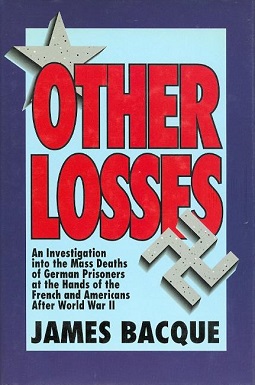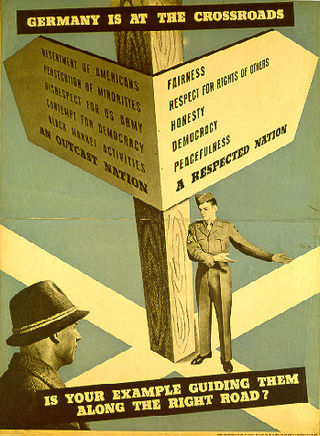
Denazification was an Allied initiative to rid German and Austrian society, culture, press, economy, judiciary, and politics of the Nazi ideology following the Second World War. It was carried out by removing those who had been Nazi Party or SS members from positions of power and influence, by disbanding or rendering impotent the organizations associated with Nazism, and by trying prominent Nazis for war crimes in the Nuremberg trials of 1946. The program of denazification was launched after the end of the war and was solidified by the Potsdam Agreement in August 1945. The term denazification was first coined as a legal term in 1943 by the U.S. Pentagon, intended to be applied in a narrow sense with reference to the post-war German legal system. However, it later took on a broader meaning.
James Bacque was a Canadian writer, publisher, and book editor. He was born in Toronto, Ontario.

Other Losses is a 1989 book by Canadian writer James Bacque, which makes the claim that U.S. General Dwight D. Eisenhower intentionally caused the deaths by starvation or exposure of around a million German prisoners of war held in Western internment camps after the Second World War. Other Losses charges that hundreds of thousands of German prisoners that had fled the Eastern front were designated as "Disarmed Enemy Forces" in order to avoid recognition under the Geneva Convention (1929), for the purpose of carrying out their deaths through disease or slow starvation. Other Losses cites documents in the U.S. National Archives and interviews with people who stated they witnessed the events. The book claims that a "method of genocide" was present in the banning of Red Cross inspectors, the returning of food aid, soldier ration policy, and policy regarding shelter building.

The history of Germany from 1945 to 1990 spans the period following World War II, from the Berlin Declaration marking the abolition of the German Reich and Allied-occupied period in Germany on 5 June 1945 to German reunification on 3 October 1990.

The Rheinwiesenlager were a group of 19 camps built in the Allied-occupied part of Germany by the U.S. Army to hold captured German soldiers at the close of the Second World War. Officially named Prisoner of War Temporary Enclosures (PWTE), they held between one and almost two million surrendered Wehrmacht personnel from April until September 1945.
Nazism and the acts of Nazi Germany affected many countries, communities, and people before, during and after World War II. Nazi Germany's attempt to exterminate several groups viewed as subhuman by Nazi ideology was eventually stopped by the combined efforts of the wartime Allies headed by the United Kingdom, the Soviet Union, and the United States.

The Bizone or Bizonia was the combination of the American and the British occupation zones on 1 January 1947 during the occupation of Germany after World War II. With the addition of the French occupation zone on 1 August 1948 the entity became the Trizone. Later, on 23 May 1949, the Trizone became the Federal Republic of Germany, commonly known as West Germany.
The CARE Package was the original unit of aid distributed by the humanitarian organization CARE. Originally CARE was dubbed the Cooperative for American Remittances to Europe, and in 1946 CARE sent the world's first CARE Package. Although "CARE Package" is a registered trademark, the term has since been widely adopted as a generic term for a parcel of food or supplies sent for relief or comfort purposes.
Government Aid and Relief in Occupied Areas (GARIOA) was a program under which the United States after the 1945 end of World War II from 1946 onwards provided emergency aid to the occupied nations of Japan, Germany, and Austria. The aid was predominantly in the form of food to alleviate starvation in the occupied areas.

The industrial plans for Germany were designs the Allies of World War II considered imposing on Germany in the Aftermath of World War II to reduce and manage Germany's industrial capacity.

The Office of Military Government, United States was the United States military-established government created shortly after the end of hostilities in occupied Germany in World War II. Under General Lucius D. Clay, it administered the area of Germany and sector of Berlin controlled by the United States Army. The Allied Control Council comprised military authorities from the United States, the United Kingdom, the Soviet Union and France. Though created on January 1, 1946, OMGUS previously reported to the U.S. Group Control Council, Germany (USGCC), which existed from May 8, 1945, until October 1, 1945. OMGUS was eliminated on December 5, 1949, and the U.S. High Commissioner for Germany assumed control of its functions.

Austria was occupied by the Allies and proclaimed independence from Nazi Germany on 27 April 1945, as a result of the Vienna offensive and ended with the Austrian State Treaty on 27 July 1955.

The forced labour of Hungarians in the Soviet Union in the aftermath of World War II was not researched until the fall of Communism and the dissolution of the Soviet Union. While exact numbers are not known, it is estimated that up to 600,000 Hungarians were deported, including an estimated 200,000 civilians. An estimated 200,000 perished. Hungarian forced labour was part of a larger system of foreign forced labour in the Soviet Union.
This is a timeline of the events that stretched over the period of late World War II, its conclusion and legal aftermath, from January 1945 to 1991.

The Berlin Blockade was one of the first major international crises of the Cold War. During the multinational occupation of post–World War II Germany, the Soviet Union blocked the Western Allies' railway, road, and canal access to the sectors of Berlin under Western control. The Soviets offered to drop the blockade if the Western Allies withdrew the newly introduced Deutsche Mark from West Berlin.
The Soviet famine of 1946–1947 was a major famine in the Soviet Union that lasted from mid-1946 to the winter of 1947 to 1948.

American food policy in occupied Germany refers to the food supply policies enacted by the U.S., and to some extent its dependent Allies, in the western occupation zones of Germany in the first two years of the ten-year postwar occupation of Western Germany following World War II.
The Commission for Polish Relief (CPR), also known unofficially as Comporel or the Hoover Commission, was initiated in late 1939 by former US President Herbert Hoover, following the German and Soviet occupation of Poland. The Commission provided relief to Nazi occupied territories of Poland until December 1941.
The Great Famine was a period of mass starvation during the Axis occupation of Greece (1941–1944), during World War II. The local population suffered greatly during this period, while the Axis Powers initiated a policy of large-scale plunder. Requisitions, together with a blockade by the Allies, the ruined state of the country's infrastructure after the German invasion of Greece, and the emergence of a powerful and well-connected black market, resulted in the Great Famine, with the mortality rate reaching a peak during the winter of 1941–42.

The American occupation zone in Germany, also known as the US-Zone, and the Southwest zone, was one of the four occupation zones established by the Allies of World War II in Germany west of the Oder–Neisse line in July 1945, around two months after the German surrender and the end of World War II in Europe. It was controlled by the Office of Military Government, United States (OMGUS) and ceased to exist after the establishment of the Federal Republic of Germany on 21 September 1949, but United States maintains military presence across Germany.












